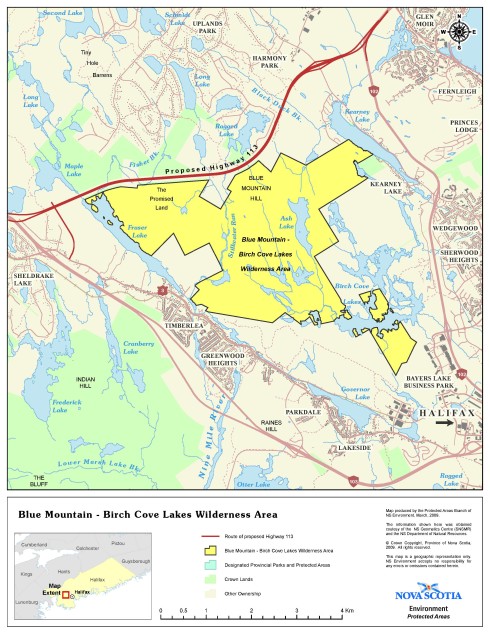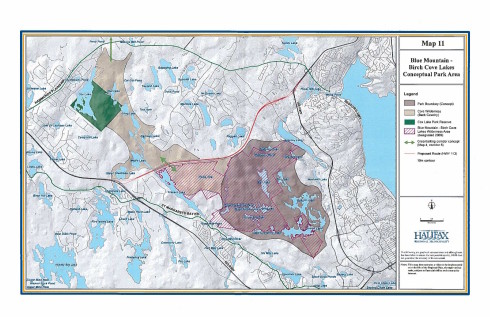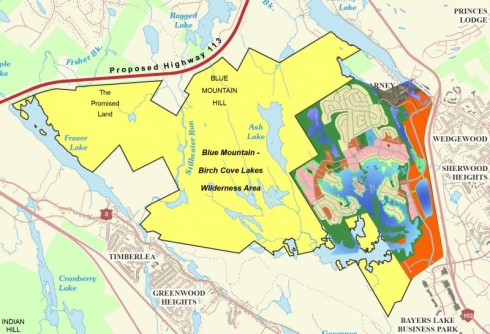Blue Mountain-Birch Cove Lakes Wilderness Area
It’s not very often that my travel writing and my day job as a lawyer converge on one topic, but that is precisely the case with the controversy that surrounded the Birch Cove Lakes a few years ago. This post will be my attempt to explain the history of the matter, the importance of protecting the Blue Mountain-Birch Cove Lakes Wilderness Area and just as importantly, the credibility of the planning process in HRM. (For those who don’t know, HRM is the massive Halifax Regional Municipality that stretches from Hubbards on the South Shore to Ecum Secum on the Eastern Shore. It includes not only greater Halifax, Dartmouth and Bedford, but large swaths of rural communities that have little in common with the city proper.
In a nutshell, HRM considered reneging on a promise to designate a large parcel of land very close to the Blue Mountain – Birch Cove Lakes Wilderness Area as parkland which would provide a large wildlife corridor between the Wilderness Area and Cox Lake Provincial Park. In our book, Outdoor Adventures in Halifax, Ryan Barry and I described a canoe trip we took through some of the Birch Cove Lakes and the many interesting natural places within eyesight of some of Halifax’ apartment buildings and industrial parks. We knew we had to speak out about the importance of preserving this wondrous area and appeared on numerous TV and radio programs expressing our believes.
Here is one example, a call-in show from July 3, 2016 on CBC which goes into more depth.
History of Blue Mountain – Birch Cove Lakes
The first thing you need to do to understand the importance of preserving the Birch Coves Lakes area is look at this map. You will see a large green area interspersed with lakes, literally just off the Bicentennial Highway. The largest lakes are closest to the road, Susie’s and Quarry, which are also referred to as the Birch Cove Lakes.
Most of the land within the triangle between Highways 102, 103 and the proposed Highway 113 was owned by the Provincial Crown which in 2007 created the Blue Mountain-Birch Cove Lakes Wilderness Area, A further addition in 2015 brought the total protected area to 1767 hectares or for the metrically challenged like me, 4366 acres. The reason for the designation was described as follows on the website – This wilderness area protects an important, intact, forested habitat patch in the midst of a fragmented suburban landscape. It includes forests, barrens and interconnected lakes and wetlands. It protects valued wildlife habitat and a range of exceptional wilderness recreation opportunities, all within minutes of Atlantic Canada’s largest urban centre.
Here’s the map of the wilderness area outlined in yellow.

How many cities in Canada boast of such a huge wilderness acreage literally within city limits?
Now the Province didn’t just create this Wilderness Area out of the blue. They did it in conjunction with HRM who at the time the Province made the wilderness designation, promised to surround the area with parkland by creating the Blue Mountain-Birch Cove Lakes Regional Municipal Park. This was no empty promise as the 2006 Regional Municipal Planning Strategy expressed the intention to create this park. Turn to page 28 to confirm this.
Here is a map of the proposed park.The area gridded in red is the Wilderness Area and the area in brown the area to be made into the Regional Park. As you can see it protects the entirety of the Birch Cove Lakes system as well as creating a wildlife corridor to Cox Lake Park Reserve outlined in green. You can see that HRM’s eventual contribution would be about the same size as the Province’s.

The city did not own all of the land that was to constitute the new park, but affirmed in the MPS p. 29, the intention to acquire the private lands over time and once acquired, designate them as Open Space and Natural Resource, zoned Regional Park. So everybody at the time thought that the Birch Cove Lakes were forever spared from development.
This remained the case right up until October, 2014 when these goals were reaffirmed once again in the Regional Municipal Planning Strategy.
The Birch Cove Lakes Park Boundary Facilitation
However, months before the October, 2014 plan was published Justice Heather Roberston was hired to facilitate how ‘to reach a consensus on the park boundaries.’ In the interests of disclosure Ms. Robertson is a former law partner and a friend. That does not mean that we see eye to eye on this issue. We clearly don’t.
The facilitation was approved by council on September 17, 2013 and the terms of reference were as follows:
Under the terms of reference (see attachment 1) the role of the independent facilitator will be to: Work with HRM and the property owners to determine how they wish to engage with each other; including the sharing of confidential information with the Independent Facilitator and non‐confidential information between the parties; Obtain parkland concepts from HRM and development plans from the property owners, and advise these parties on areas of common agreement; Assist with coming to common terms between HRM and the property owners on parkland boundaries and financial terms, and conditions for parkland designation that are acceptable to the parties; Prepare an Independent Facilitators Report that identifies areas of common agreement on parkland boundaries and (if necessary) areas of disagreement. The report will also indicate the methodology and approach used to determine the value of the land.
In reading the preamble to this document I note that the area is now being referred to as ‘a potential regional park’. So somehow it has gone from a definite regional park with fixed boundaries and an intention to acquire the lands to make it happen, to just a possibility.
There are a number of things in the facilitation mandate that are disturbing and in my opinion, just plain undemocratic. These are:
1. Only HRM and the landowners will be party to the process. This infers that all other HRM residents have no stake in this, which is absolutely contrary to numerous parts of the MPS including the Guiding Principle which states:
Guiding Principle
This Plan will seek to address the needs and views of all sectors of HRM, recognizing the diversity of its citizens, community and geography.
2. The landowners are not only at the table, but are the ones who will actually have to agree to the park boundaries.
TERMS OF REFERENCE Article 1. HRM and the property owners will:
(c) explore with one another potential parkland boundaries, the financial terms and conditions for parkland acquisition, and the location of parkland dedication, that are acceptable to the parties. emphasis added
So not only do the developers get to pick the boundaries, but they get to enhance the value of their property by getting it to abut directly on a designated Wilderness Area. No, they wouldn’t be that obviously cynical would they?
3. Only after the developers have agreed to the boundaries does the public get let in on the discussion. Sorry, wrong word. The public were not allowed any discussion on this from day one.
Justice Robertson met with the landowners and HRM eight times over a two year period. We know what they would want, but what about the professional planners at HRM? Well they were not so sanguine. Here’s what HRM Park staff had to say.
HRM Park staff considers that the Development Plan fails or only minimally achieves many of the regional park objectives … and then goes on to list ten areas in which it is deficient or minimalist.
OK, so what are these proposed park boundaries and how closely do they resemble the original concept? You have to see this map to believe it. Compare it to the map above with original proposed boundary.

Yes, Quarry Lake will be completed surrounded by homes and condos and Susie’s Lake fares little better. And I thought the developers wouldn’t be so crass as to actually want to build right up to the Wilderness Areas boundaries. This is an abomination and study in greed. But hey, they have agreed to sell an area for parkland that is about ten % of the original proposed boundary. All they want is over double the estimated market value.
I really didn’t think things like this could happen in a modern Canadian city in this day and age. And hey, if you are as pissed off as I am (just blew six billable hours researching and writing this), you missed the deadline for submissions to council which was yesterday.
This issue strikes at the very heart of the future of HRM. I urge every reader to make it a priority in the upcoming fall elections.
In the meantime if you like cycling I highly recommend taking the rails to trails system from Halifax to the Bike and Bean in the old French Village train station in Tantallon.

